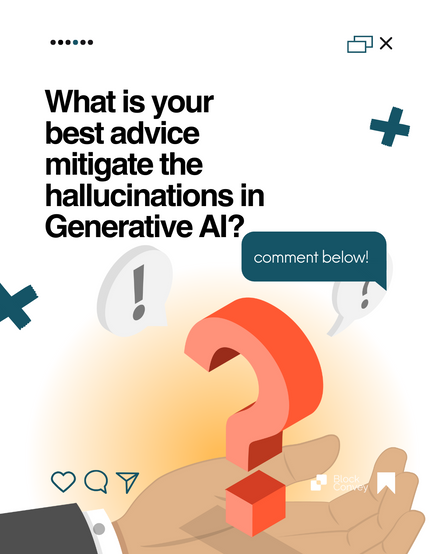How Can Organizations Mitigate the Risk of "Hallucinations" in Generative AI?
1. How Can Organizations Mitigate the Risk of "Hallucinations" in Generative AI?
Generative AI, with its incredible capacity to create content, poses a risk of producing inaccurate or misleading information, often referred to as "hallucinations." How can organizations effectively address this ethical concern?
To combat the risk of hallucinations, organizations can start by adjusting the "temperature" of their AI models. This parameter controls the level of creativity in the generated content. Lowering the temperature makes responses more deterministic, while increasing it introduces more randomness. Striking the right balance is crucial to ensure accurate and contextually appropriate responses.
Augmenting AI models with relevant internal data is another valuable strategy. By providing context and grounding responses in factual information, organizations can reduce the chances of generating misleading content. This context can be derived from various sources, such as proprietary databases, historical records, or structured knowledge bases.
Furthermore, using libraries that impose guardrails on generated content is essential. These libraries can restrict the AI from producing harmful or inappropriate outputs. Implementing "moderation" models that assess generated content for adherence to guidelines and standards is another layer of protection.
Clear disclaimers are also crucial. Informing users that they are interacting with an AI-generated system and that the information provided should be verified for accuracy can help manage expectations and mitigate the impact of any potential hallucinations.
2. How Can Organizations Safeguard Against the Accidental Release of Confidential Data?
Protecting data privacy is paramount when working with generative AI. One of the most significant ethical concerns is the unintentional release of confidential personally identifiable information (PII). How can organizations safeguard against this risk?
First and foremost, organizations should establish robust sensitive data tagging protocols. Identifying and categorizing sensitive information within datasets is essential to prevent its inadvertent use in AI model training. Properly tagged data can be handled with extra care, reducing the likelihood of PII exposure.
Data access controls play a pivotal role in safeguarding confidential information. Implementing strict access restrictions ensures that only authorized personnel can access sensitive data. This approach extends to different domains, such as HR compensation data, where access should be tightly controlled.
When sharing data externally, extra protection measures are necessary. Encryption, anonymization, and secure data-sharing agreements should be part of the process. Organizations must prioritize data privacy when collaborating with external partners or utilizing third-party services that involve data sharing.
Including privacy safeguards in the AI development process is essential. Privacy impact assessments, data protection impact assessments (DPIAs), and thorough audits can help identify and rectify potential data privacy issues before they escalate.
3. How Can Organizations Address Inherent Bias in Generative AI Models?
Bias in generative AI models, often stemming from biased training data, poses ethical concerns. How can organizations tackle this issue and ensure responsible AI deployment?
Addressing inherent bias requires organizations to become fluent in ethics, humanitarian issues, and compliance standards. Simply adhering to legal regulations is not sufficient. Organizations must strive to uphold the spirit of responsibly managing their business's reputation and ethical standing.
Transparency is key. Organizations should document their data collection and model training processes meticulously. This includes maintaining records of data sources, preprocessing steps, and any interventions made to mitigate bias.
Regular bias audits and fairness assessments should be conducted to identify and rectify biases in AI models. Machine learning fairness tools can help in quantifying and addressing bias, ensuring that AI systems are equitable and fair for all user groups.
Diverse and representative training data are fundamental to reducing bias. Organizations should prioritize collecting data from diverse sources and communities to create models that reflect a more comprehensive range of perspectives and experiences.
In conclusion, navigating the ethical challenges in generative AI necessitates a multi-faceted approach. By fine-tuning model creativity, safeguarding data privacy, and addressing bias, organizations can harness the transformative potential of generative AI while upholding ethical standards and mitigating risks. Early use cases should focus on low-cost error areas to learn from setbacks and continuously improve AI systems.















